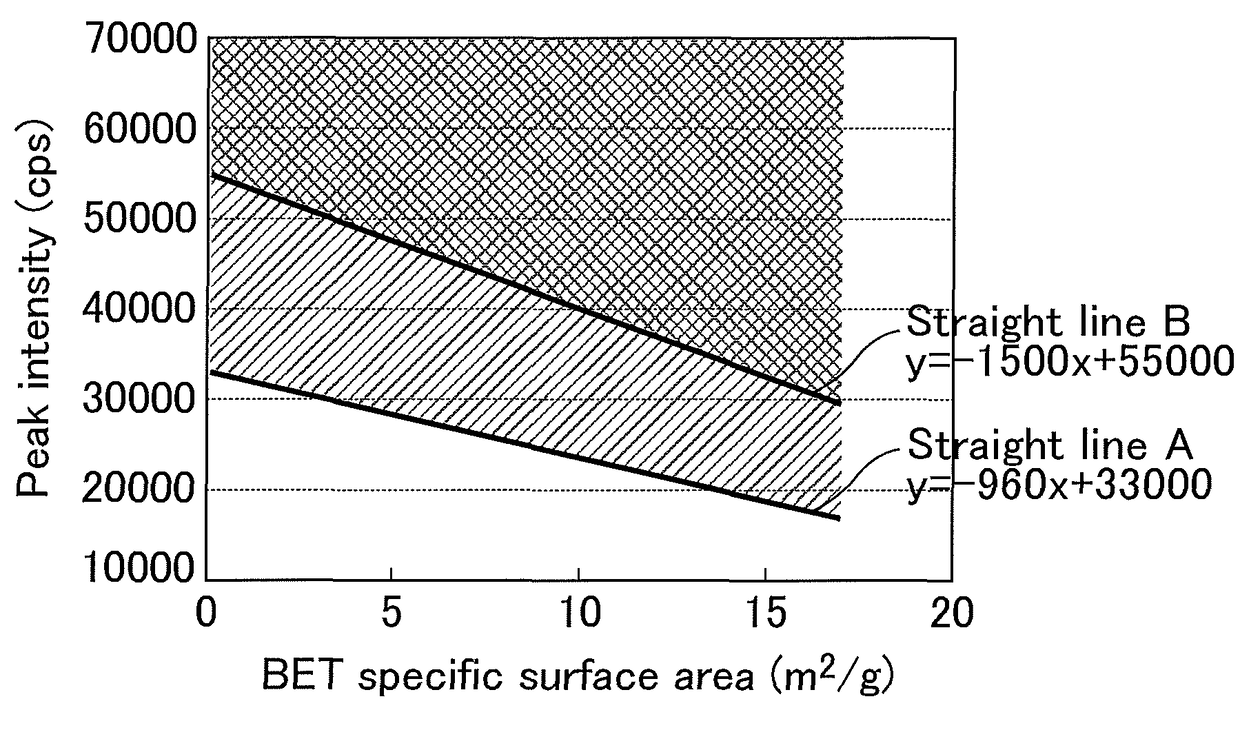Magnesium oxide particles, magnesium oxide particle production method, resin composition and molded body using such resin composition, and adhesive or grease
a magnesium oxide and magnesium oxide technology, applied in magnesia, magnetic/solid-state device details, thickeners, etc., can solve the problems of errors in control of electronic components, adhesives, etc., to prevent soft errors in memory, excellent crystallinity, and high heat conductivity
- Summary
- Abstract
- Description
- Claims
- Application Information
AI Technical Summary
Benefits of technology
Problems solved by technology
Method used
Image
Examples
example 1
[Step of Removing α-Ray-Emitting Substance from Aqueous Magnesium Chloride Solution]
[0128]In a 3-L beaker, 1000 mL of a 396 g / L aqueous solution of magnesium chloride (extra-pure reagent from Wako Pure Chemical Industries, Ltd.), 570 mL of a 200 g / L slurry of titanium compound mainly containing hydrous titanium oxide (from Sakai Chemical Industry Co., Ltd.), and 500 mL of pure water were mixed by stirring. To the mixture was added an aqueous solution of sodium hydroxide (extra-pure reagent from Wako Pure Chemical Industries, Ltd.) to control the pH to 6 to 7. The mixture was stirred at 25° C. for 24 hours, and then filtered so that an aqueous magnesium chloride solution (filtrate) from which the titanium compound mainly containing hydrous titanium hydroxide and α-ray-emitting substances were removed was obtained.
[0129]Here, the titanium compound mainly containing hydrous titanium oxide showed a weight loss of 14.0% by mass when heated at 400° C., had a BET specific surface area of 2...
example 2
[Step of Calcining Basic Magnesium Carbonate to Produce Magnesium Oxide]
[0139]By the same procedure as that in Example 1, basic magnesium carbonate was produced, and white powder mainly containing the basic magnesium carbonate obtained was calcined at 1100° C., so that white powder was obtained. The white powder, when analyzed by an ICP optical emission spectrometry, showed an MgO purity of 99.6 wt %, an X-ray diffraction pattern with a main peak attributed to magnesium oxide, a peak intensity at 2θ=42.888° of 55696 cps, a BET specific surface area of 3.61 m2 / g, and an α dose of 0.001±0.001 c / cm2 / h.
[Measurement of Heat Conductivity of EEA Resin Molded Body]
[0140]A LABO PLASTOMILL (10C 100 from Toyo Seiki Seisakusho, Ltd.) was charged with 59.5 g of the magnesium oxide obtained by the method above and 10.0 g of EEA resin (A-1150 from Japan Polyethylene Corporation). The components were kneaded at an internal device temperature of 150° C. and a rotor speed of 40 rpm for 10 minutes, an...
example 3
[Step of Calcining Basic Magnesium Carbonate to Produce Magnesium Oxide]
[0143]By the same procedure as that in Example 1, basic magnesium carbonate was produced, and white powder mainly containing the basic magnesium carbonate obtained was calcined at 1250° C., so that white powder was obtained. The white powder, when analyzed by an ICP optical emission spectrometry, showed an MgO purity of 99.7 wt %, an X-ray diffraction pattern with a main peak attributed to magnesium oxide, a peak intensity at 2θ=42.890° of 58294 cps, a BET specific surface area of 1.69 m2 / g, and an α dose of 0.001±0.001 c / cm2 / h.
[Measurement of Heat Conductivity of EEA Resin Molded Body]
[0144]A LABO PLASTOMILL (10C 100 from Toyo Seiki Seisakusho, Ltd.) was charged with 59.5 g of the magnesium oxide obtained by the method above and 10.0 g of EEA resin (A-1150 from Japan Polyethylene Corporation). The components were kneaded at an internal device temperature of 150° C. and a rotor speed of 40 rpm for 10 minutes, an...
PUM
| Property | Measurement | Unit |
|---|---|---|
| 2θ | aaaaa | aaaaa |
| BET specific surface area | aaaaa | aaaaa |
| temperature | aaaaa | aaaaa |
Abstract
Description
Claims
Application Information
 Login to View More
Login to View More - R&D
- Intellectual Property
- Life Sciences
- Materials
- Tech Scout
- Unparalleled Data Quality
- Higher Quality Content
- 60% Fewer Hallucinations
Browse by: Latest US Patents, China's latest patents, Technical Efficacy Thesaurus, Application Domain, Technology Topic, Popular Technical Reports.
© 2025 PatSnap. All rights reserved.Legal|Privacy policy|Modern Slavery Act Transparency Statement|Sitemap|About US| Contact US: help@patsnap.com


